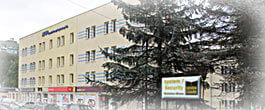Practically, all institutions and even some private persons must find the effective protection methods for their valuable resources (information, data, documents, objects, etc.) from unauthorised persons’ access or at least find reliable method to find whether such access could have happened, which prevents from unauthorised disclosure, copying, theft or damage.
In relation to the whole facilities, or even individual rooms, this task may be partly realised while using alarm systems, television systems and access control. However, in case of particular cabinets, safes, drawers and similar spaces, in which the important resources can be found, such solution is practically ineffective. It results from the significant increase of such systems complication while trying to cover many small objects with them selectively, which results in the rapid growth of their price, exploitation cost, failure frequency, comprehensive operation and creation in their memory a huge number of records difficult to be analysed.
Such solutions have also one very essential drawback: because of their “centralising” in case of failure (or damage on purpose) of the central unit or its important circuits, they deprive all subordinate areas of the protection, which makes impossible to find out, whether in that time some unauthorised access to the protected resources occurred. And in case of “gaining” by unauthorised persons of the codes or copies of identifiers with suitably high access level, such solution is ineffective.
So how to deal with ensuring the inviolability of the valuable content?
Even in the ancient times, there were used various methods of sealing (e.g. the cylindrical seals from Mesopotamia – figure beside).
Even today there are still used the similar solutions consisting in putting on the paper, plastic, metal or plasticine basis the “unique” marking and making use of such set as a seal.
Unfortunately, for those tens of centuries, many things have changed in the world, the level of commonly used technologies is completely different as well.
In the 21st century making the true copy of typical paper, plastic, metal seal is really not a problem (especially that mass-produced models of such seals are cheap and available to all people), and various techniques of printing, pressing or engraving on any base are at present close at hand.
Therefore, during normal use it is really difficult to state whether the checked seal is the very one, that was placed there before or its true copy (not to mention the known method of “traceless” opening of many types of seals while using uncomplicated tools).
In most cases without conducting a specialist testing it is impossible to state, whether unauthorised access to the protected space happened or not. Of course, for different types of seals, the certainty level is different. In case of plasticine “seals” this level is close to 0, because true reference copy of any such “seal” can be made within 1-2 minutes, using the common materials.
So, is there any better solution?
Yes, it is known and used already in the 20th century: the electronic seals. Although these seals have been produced for several years, the so-far constructions had as a rule at least one of three drawbacks: they were big, expensive or complicated to operate.
Only the company SYSTEM 7 Security, after many years of constructional works and tests, have introduced to the market: small, cheap and simple in their use electronic seals.
These seals provide the certainty level of seal integrity not lesser than the best traditional seals, and moreover they allow to find out who and when opened/closed them, they signalise optically and acoustically the fact of integrity breaking, have unique number and name determined by the user and are practically impossible to fake.
Currently there are available two models of those innovative seals:
1. SGSL1 – electronic threading seal.
It replaces traditional seals with sealing cord mounted outside the protected space (e.g. so-called plasticine “seals”). Due to its small size and smart construction of the sealing cord catches, it may be hang on that cord without fear of accidental opening.
2. SGSL2 – electronic seal with magnetic sensor.
The ideal solution for protecting the space where the seal may be mounted “inside” and available only after opening (e.g. inside safe deposit boxes, cabinets, safes, drawers, device housings, doors to rooms, etc.).
The seals SGSL are supplied from small and cheap lithium batteries (battery is for ca. 1 year of use) and they have non-volatile memory of 1344 last events. The seal dimensions: 21 mm x 40 mm x 50mm, weight ca. 50 g, operation temperature from -25°C to +60°C.
Authorised users (up to 235 for each) may authorise in the seal the activities done by them by means of small personal identifiers (pendants) with unique digital code.
These seals are less expensive in operation than medium-quality traditional seals, and in case of closing/opening more frequent than once a day – SIGNIFICANTLY cheaper!
Please contact our trade department.
